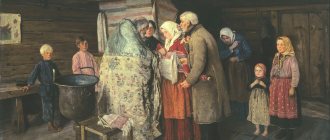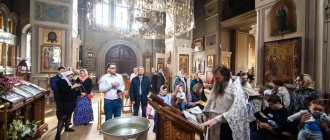4 August
Back
Baptism in the Armenian Apostolic Church
has its own characteristics and traditions. To understand them, it is worth turning to the history of religion. The Armenian Church belongs to a branch of Monophysitism. This branch of religion is a creed that recognizes the only principle in the Savior.
Supporters of the Monophysite churches agree that there is only one will in Jesus, and its only source is his divine nature. This is the main difference between the doctrine and the Orthodox, which sees both the human and divine principles in the Savior.
Armenian baptism
takes place with the performance of ritual actions similar to long-standing East Syrian traditions. All prayers and actions performed during the baptismal rite are similar in meaning and order to the actions that are determined by the Byzantine rite of Baptism. Careful preparation is necessary before the sacrament. It is necessary to consider in more detail the preparatory stages and the sequence of events during the ritual.
Beautiful male Armenian names
List of the most beautiful names in Armenia for boys:
Armenian Abig - singing Avet - light of God, knowledge of God Agasi - steadfast Azat - free Hayk - name of the founder of the Armenian people Hakob - protected by God Amazasp - protector winner Hmayak - honest in spirit Ambartsum - ascended to heaven Amo - traveler Anania - unique Ara - highly moral Arakel - Angel, protector Aram - highly moral Argam - deserving Argishti - deserving of love Areg - heavenly body, sun Aristakes - divine protector Armen - warrior, dream Arsen - true fighter Artavazd - truthful Artak - reaches for the sun Artash - reaches for the truth Artem - the road of truth Arthur - bear, the light of truth Artush - reaches out to the light Harutyun - revival, Sunday Arushan - sunny-faced Arshavir - bright winner Arshak - courage Atom - Soul of God Ashot - fiery Babken - wise ancestor; Bagdasar - the power that gives good Bagish - happy; Bagram - happy and beloved Bagrat - joyful, beloved; Barseg - powerful Barkhudar - respecting strength Vahagn - flame Vaan - universal protection Vagharsh - omnipresent luminary Vagram - fast like a tiger Vazgen - the joy of holy knowledge Vanik - merchant Varazdat - heavenly gift Vardan - retribution Vardvan - loyal subject Vardges - ruler of the country Varuzhan - protector Vasak - light eyes Vahak - an all-penetrating ray of sunshine
How Catholics baptize children
It is customary for Catholic Christians to baptize children at a special liturgy of Baptism of Children, which is usually held on Sunday. Unlike Orthodox Baptism, both the child’s parents and recipients are necessarily present at the Sacrament. The family must be churchgoers and have an understanding of the Christian faith. According to the Code of Canon Law, “for a child to be validly baptized there must be a reasonable expectation that he will be brought up in the Catholic faith. If this is completely absent, then baptism should be postponed in accordance with the requirements of particular law, notifying the parents of the reason for this.”
The ceremony is carried out in the same way as for adults. The responsibility for raising a child in the faith of Christ falls on parents and godparents. They take an active part in the ritual, for example, following the priest, they draw a cross on the baby’s forehead. Next, the liturgy continues with the rite of renunciation of the unclean, where parents and children renounce the devil and read the Creed. Afterwards, everyone goes to the font for the priest to pour the child over the head three times. The baby is received from the font by his parents or godparents and dressed in a white outfit.
Confirmation or the rite of confirmation in the church among Catholic Christians of the Western rite is performed at a conscious age, as a rule, at 13-14 years. The first communion is celebrated earlier - at 7-12 years of age.
Among Catholics of the Eastern Rite, Confirmation is performed on the child immediately after Baptism.
Clothing for children's baptism in a Catholic church
For infant Baptism, Catholics usually use a white robe and cap, as well as a white blanket.
We can offer wonderful white terry robes (there are models with colored inserts) for boys and girls. They are warm, come with a hood and a belt, and absorb water perfectly.
Caps are available to choose from: thin lace and warm ones made of soft flannel.
Any terry towel or blanket from our catalog can be used as a cloth in which to wrap the child after the bath.
As the practice of our workshop shows, people living abroad and wishing to baptize their children into the Catholic faith actively buy shirts of our production with ornamental embroidery or simply lace. On request we can embroider a Catholic cross.
Beautiful female Armenian names
List of the most beautiful names in Armenia for girls:
Avat - Vera Aveta - Good News Agavni (Akhavni) - dove Agunik (Ahunik) - turtle dove Adrine (Adriana) Aza - from Azniv Azarvard - a thousand roses Azatui - free Azganush - nationally pleasant Azgush (Azniv) - honest Ayarpi - sunshine Hayastan - Armenia Aygavart - garden rose Aiganush (Aykanush) - pleasant Aykanush - Anna Aykui - dawn Aykush - the best Aytsemnik - goat Ak - eyes Alvan (Scarlet) Alvard - red rose Almast - diamond Amest - modest Anaida heart Anait (Anaida) - heart Ananukh - mint Anakhit - pure Angin - priceless Anelik - the task of Ani - the medieval capital of Armenia Annman - unique Antaram - unfading Anush - breath of the morning, sweet Anushik - breath of the morning Arazgul - flower Araik - bestowed by the supreme god Arai Araxia - sacred watch Araksya (Araksi) - from the river Araks Arev (Areg) - sun Arevgat - a piece of the sun Arevik sun Arzum - desired, long-awaited Armaveni - blooming Armaghal (Armalan) Armanush - beautiful late flower Armine - fate Arpenik - holy protector Arpi - sun Arpig (Arpik) - sun Arpina - rising sun Arpine – sunny Arus – sunny
Features of Armenian names
Christianity had a great influence on the formation of Armenian names. At the moment, it is customary to use native Armenian names throughout the territory of Armenia. In other countries, sometimes the name may be borrowed, but the surname remains the same. It is customary to call a child by his first name on his birthday, then add a second name at baptism. The surname comes from the father. Middle name is optional.
In many names you can find gender differences - ayr for men and dukht for women. For example, Zarmair or Aikandukht. There are borrowed names that are considered Armenian. These are Seda, Samvel and others.
Modern Armenian names can be divided into:
Interesting facts about Baptism:
- “Baptism” is a word of Slavic origin and means “immersion.” Symbolizes dying to a past life. Therefore, during the Sacrament, a person is immersed three times with his head in water - in that environment where he cannot live independently: in the name of the Father he dies (immersion in water) in order to come to life in the name of the Father (exit from the water), dies in the name the Son and comes to life in the name of the Son, just as he dies in the name of the Holy Spirit in order to now live in the Holy Spirit.
- The baptismal outfit for a newborn representative of the royal family in Rus' was trusted to be sewn only by the most famous craftswomen and from the highest quality fabrics, most often silk. Exquisite Brussels lace was chosen for decoration. In addition to the baptismal shirt, the Baptism set included a towel with rich embroidery, a scarf for a girl or a cap for a boy. The baptismal accessories of the royal children were carefully preserved as the greatest value. The baptismal attire of Tsarevich Alexei, the son of the last Russian Tsar Nicholas II, has been preserved to this day.
- Until the 12th century, Baptism was performed exclusively by immersion. But representatives of the Catholic Church simplified the ceremony, making it more comfortable - they began to baptize by pouring water on the head. Some churches even practiced Baptism not with water, but with rose petals.
- The Sacrament of Baptism for a boy and a girl is no different, except for the final “chord” when the boy is brought into the altar and the girl is left outside.
- In Georgian churches, the Baptism process is the same as in the Russian Orthodox Church, but the requirements for details are slightly different. For example, the cross should be made of wood, and the embroidered cross on a shirt should be located on the back. There are also no differences in the ritual, except that there can be any number of godparents. It is believed that in this case the child is better protected. In shirts they prefer a grape theme and a special type of cross: St. George’s, symmetrical, four-pointed, it is also called Bolnisi.










